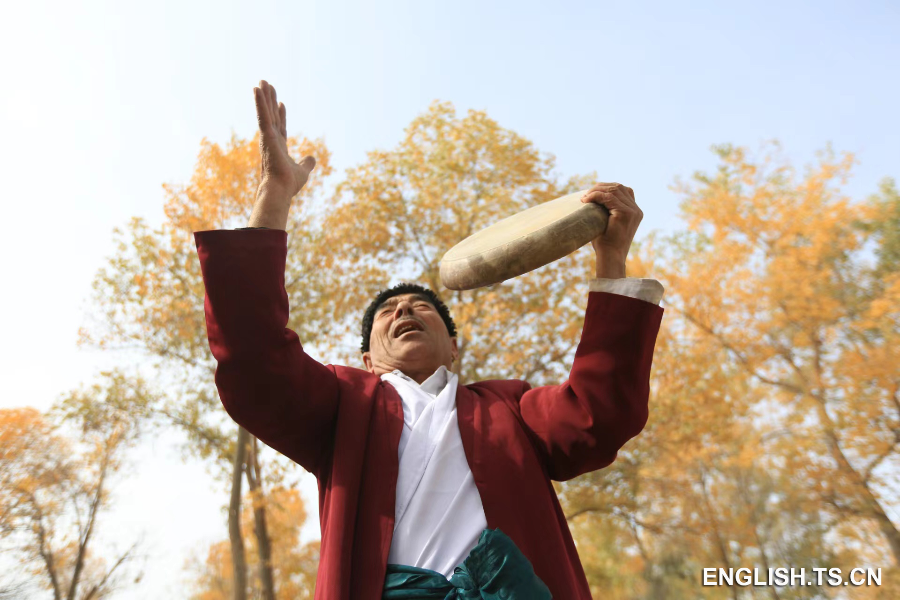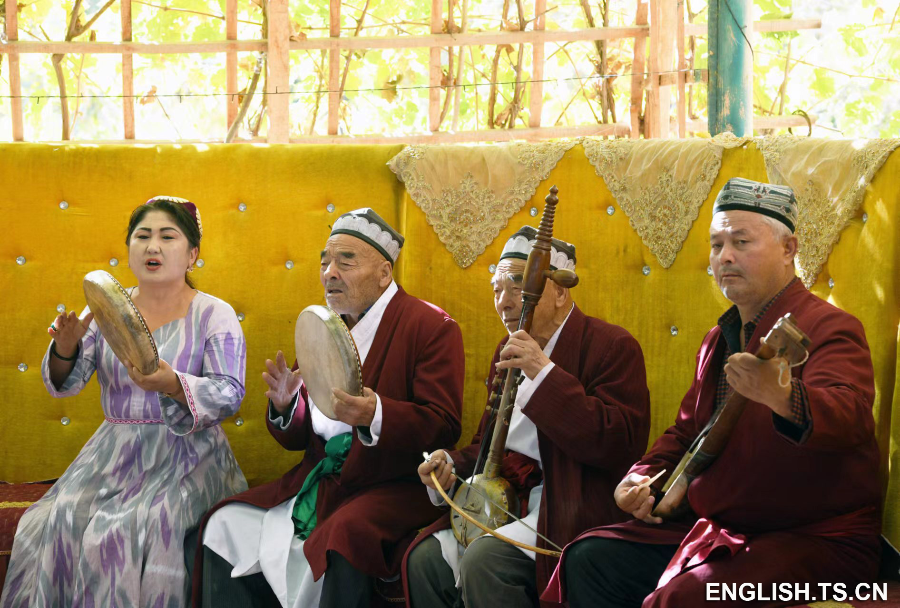Tianshannet-Xinjiang Daily (Reporter Yin Lu) news: One day in mid-November, the Dolan Tribe scenic spot in Yangtake Township, Makit County, was buzzing with the sound of drums, songs, and resounding dance steps: an exciting Dolan Muqam performance was underway. Yusuyin Yaya, who had just been discharged from the hospital, came to see his apprentices perform, and later couldn’t help picking up the tambourine and singing: “Hey, if you see my lover, please send her my greetings...” His voice was still strong and traveled far.

Photo shows Yusuyin Yaya performs Dolan Muqam in Makit County, Kashi Prefecture, northwest China’s Xinjiang Uygur Autonomous Region. (Photo provided by Culture, Sports, Radio, Television and Tourism Bureau of Makit County)
The Uygur Muqam of Xinjiang was inscribed on the Representative List of UNESCO’s Oral and Intangible Heritage of Humanity in November 2005. The 83-year-old Yusuyin is a national representative trustee of Uygur Muqam of Xinjiang (Dolan Muqam). Over the years, with his bright, high-pitched and wide voice and his love for Muqam, he has brought the Dolan Muqam art out of the countryside and to the world stage.
On the beautiful banks of the Yarkant River, as the sun sets, a group of Dolan Muqam artists sit cross-legged on the sand with tambourines , Dolan Rawap, Gijak and other musical instruments.
With the loud and clear roar of the song, the earth-shaking drums immediately capture the audience’s heart. The girls and boys dance vigorously to convey the power of the song... This is the most authentic, impressive and moving performance of the Dolan Muqam, and also Yusuyin’s favorite stage.
Among the varieties of Uygur Muqam in Xinjiang, Dolan Muqam is famous for its free-spirited personality and vigorous melodies and dances. Its songs, dances and melody are full of folk artists’ love of life, desire for nature, longing for beauty, and gratitude for harvest.
Yusuyin’s memory is so good that to this day he can still sing all the nine songs of Dolan Muqam, an ability he attributes to the musical atmosphere he has been immersed in since his childhood.
“My elder brother and I both grew up singing Dolan Muqam and found our favorite instrument at an early age: I love the tambourine and my brother loves the Gijak.” Yusuyin said that growing up with his twin brother, Aishan Yaya, they became the best partners in the Dolan Muqam performance.
Even with their talent, Yusuyin and his brother were humble and studious, constantly seeking advice from folk musicians. “The tambourine has just one pitch. The key is in the rhythm of the beats. When you play the tambourine while singing, the beat rhythm tells whether you are happy or sad, calm or excited.” Yusuyin said that Dolan Muqam is a group performance, and the chief drummer shall coordinate and lead all the drummers to maintain a uniform rhythm, and to cooperate with the players of other instruments.

Photo shows Yusuyin Yaya (second from left) performs with his brother (second from right) in Makit County, Kashi Prefecture, northwest China’s Xinjiang Uygur Autonomous Region. (Photo provided by Culture, Sports, Radio, Television and Tourism Bureau of Makit County)
An excellent singer and player, Yusuyin is also good at making tambourines. He made all his tambourines which are particularly obedient in his hands.
“Bang, rat-a-tat... Can you hear the difference? You must use the right force to stretch the drum skin; you want it tight, but the drum skin will shrink when it dries, and you don’t want it too tight to break.” Yusuyin is always patient when teaching apprentices the essentials of making tambourines.
Throughout their years of performing, Yusuyin and his brother have remained each other’s partners and soul mates in the pursuit of artistic perfection from their teenage years to their twilight years.
In recent years, with the rapid development of tourism in Makit County, there have been more and more cultural festivals. Whether it is the peak season or off season of farming, the Dolan Muqam artists are always ready to go and perform.
A common scene in the village: While peeling corns in the yard, Yusuyin hears his brother call him to perform. He responds while patting the crumbs off his clothes, goes into the house to pick up the bag carrying his tambourine and costumes, and leaves with his brother. After arriving at the scene, they would change into the costumes, hold the tambourine, and win rounds of applause from the audience with their wonderful performance. Afterwards, they would take off the costumes and put them in the bag, get on the three-wheeled motorcycle, and rush back home to continue with the farm work.
Now Yusuyin is too frail to do farm work, but as long as there is a government-organized performance, he and his brother will certainly go. He never forgot his mission as a folk artist. He knows well that the strength he draws from this land is the source of the Dolan Muqam art.
From the 1980s on, the folk artists of Dolan Muqam in Makit have brought the art out of their small villages on the edge of the desert and out of Xinjiang. Yusuyin and his brother and their fellow artists traveled to Beijing, Shanghai, Suzhou, Hangzhou, Tianjin, and Harbin to perform, spreading the masculine sound of the desert and the poplars to all corners of the country. At the same time, by participating in international cultural festivals, they brought Dolan Muqam performances to France, Japan, the UK, the Netherlands, among other countries.
From riding a donkey to perform in nearby townships to taking an airplane to perform abroad, Yusuyin was overwhelmed with emotion: “As a folk artist, I am immensely grateful.”
As a national representative trustee of intangible cultural heritage, Yusuyin receives RMB 20,000 in government subsidies every year. Old as he is, he is still full of passion for passing down the Dolan Muqam techniques, and he never stops cultivating the inheritors and performing enthusiasts. At present, there are more than 500 inheritors of Dolan Muqam at all levels and folk artists in the county.
Every time he walks into the campus of Makit County Vocational Secondary School, Yusuyin, as a guest teacher, is always beaming with smiles. Since the school opened the Dolan Muqam art class and the program for cultivating inheritors of the intangible cultural heritage, he has put his heart and mind into cultivating his “successors”. He hopes that the students will learn something and become better after each class, and eventually make good inheritors.

Photo shows Yusuyin Yaya (second from right) performs with the younger generation of inheritors in Makit County, Kashi Prefecture, northwest China’s Xinjiang Uygur Autonomous Region. (Photo provided by Culture, Sports, Radio, Television and Tourism Bureau of Makit County)
Patiguli Reheman, a teacher of Makit County Vocational Secondary School, has learned Dolan Muqam from Yusuyin for 22 years. “He told us that you cannot sing the eagle’s shrill under the roof; you must sing to the nature, and sing to the masses, to truly grasp the Dolan Muqam techniques.” After years of practice, Patiguli gradually understood what her teacher meant. Now she is an autonomous region-level representative trustee of Dolan Muqam.
The school enrolls more than 100 students into two classes each year, who mainly study Dolan Muqam, Dolan Meshrep, music theory, musical instruments, singing and related general culture courses. To Yusuyin’s delight, a growing percentage of the graduates work as professional performers.
Yusuyin has another wish: “The art of Dolan Muqam belongs to China and the world. My students are better educated than I am and are quick learners. I hope they can pass on this art and cultivate more young inheritors of Dolan Muqam, and take this art to more places afar.”









